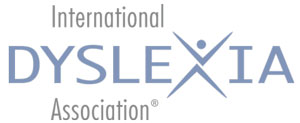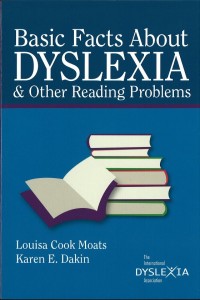By Margaret R. Balboni
March 2016
Basic Facts About Dyslexia and Other Reading Problems, by Louisa Cook Moats and Karen E. Dakin, provides a straightforward book about reading for parents and educators. This IDA publication is divided into ten easy-to-read chapters that offer readers a window into the complexities of dyslexia and other language-based reading and writing difficulties. The authors introduce the basics and help to develop an understanding of the important issues surrounding dyslexia.
Basics Facts begins by sharing an up-to-date standard definition of dyslexia approved by the International Dyslexia Association and the Director of Reading Research at the National Institute of Child Health and Human Development. The authors share their rationale for providing all stakeholders involved in the life of a struggling child with a working definition as well as dispel common misunderstandings surrounding dyslexia.
This discussion is followed by specific information on the identification and treatment of dyslexia. The authors outline how dyslexia manifests across the grades into adulthood. Indicators for parents, educators, and other decision makers are provided as a guide to think more deeply about why a child may be struggling to learn to read and how dyslexia presents differently at different stages of schooling. Critical foundational skills necessary for later reading success are listed in simple fashion complete with illustrative examples and drawings.
Moats and Dakin do an exceptional job of clearly explaining the role of cognitive neuroscience and genetics that contribute to the understanding of why it is essential for educators to instruct the brain’s circuits involved in learning to read.
The authors convey the all important message that effective teaching matters. Components and characteristics of effective instruction are delineated using a bulleted list as are helpful tips to manage language and listening problems in the classroom.
Basic Facts continues with a glimpse into severe dyslexia and the emotional consequences that affect struggling readers. The authors end with the essential message that although dyslexia continues to affect people throughout life, individuals with dyslexia are often resourceful and effective problem solvers who find success across a wide variety of disciplines despite their challenges with reading.
Moats and Dakin leave the reader with a rich list of web-based resources that offer the opportunity to learn more about the complexities of dyslexia, programs to reinforce learning, and information to build a network of supports.
As the field of reading moves toward the use of common language for the diagnosis and treatment of dyslexia it would be wise for teams of educators to utilize this guide.
Margaret Balboni is currently a Mentor for Literacy How in North Haven, Connecticut. Her experiences include classroom teacher, remedial reading teacher, language arts consultant, and coach. Most recently she revised 10 full-day modules on the science and classroom application of teaching reading including three new modules: Oral Language at the Core, Elements of Speaking and Listening, Parts I and II, and Syntax: Comprehension Begins with the Sentence.
Click here to visit the IDA bookstore today and purchase your copy of Basic Facts about Dyslexia and Other Reading Problems and other IDA publications.
The opinions of this reviewer are not necessarily the opinions of the International Dyslexia Association.
Copyright © 2016 International Dyslexia Association (IDA). We encourage sharing of Examiner articles. If portions are cited, please make appropriate reference. Articles may not be reprinted for the purpose of resale. Permission to republish this article is available from communications@interdys.org


